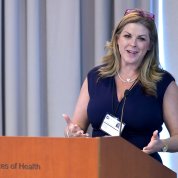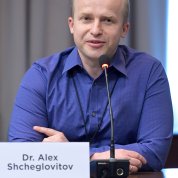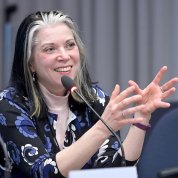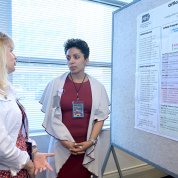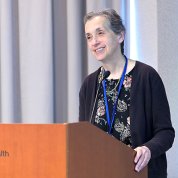NINDS, Nonprofits Discuss Cell and Gene Therapies, Big Data

Photo: Marleen Van Den Neste
Representatives from more than 50 nonprofit organizations across the country recently joined NINDS at its 13th nonprofit forum “Progress through Partnership.” The 1½-day meeting at the Neuroscience Center gave patient advocacy groups an opportunity to learn about NIH, NINDS and other federal programs, share common interests and interact directly with program staff.
Dr. Lyn Jakeman, director of NINDS’s Division of Neuroscience, introduced the NIH 101 session. “This meeting is really a lot of fun for us to do,” she said. “We get a chance to meet with a lot of you and your organizations one on one in various settings across the country, but this is a chance for you to come to our home base.”
Dr. David Owens of NINDS's Division of Extramural Activities and Dr. Ernie Lyons of the Scientific Review Branch provided an overview of NIH and NINDS basics. Dr. Jill Morris, a program director in the Neurogenetics Cluster, presented “A Day in the Life of a Program Director.”
“What I really like about my job is that every day is different,” she said. “We are responsible for many different types of activities and we really value the contributions that advocacy groups make in research. [They] are very essential at identifying patient needs and bringing together the patient communities, which is [important] for recruitment in studies and clinical trials and for developing registries. And, they also help us identify gaps in the research, provide funding opportunities and bring together researchers.”

Photo: Marleen Van Den Neste
After a welcome by NINDS deputy director Dr. Nina Schor, the meeting featured panel discussions on emerging technologies and topics such as cell therapy, gene therapy and gene editing moderated by forum committee members Dr. Cynthia Rothblum-Oviatt of the A-T Children’s Project and Ronald Bartek of the Friedreich’s Ataxia Research Alliance.
At the end of the day, representatives attended a reception and poster session featuring information on key nonprofit and NINDS initiatives.
Dr. David Adams, NHGRI deputy director of clinical genomics, kicked off day 2 with a presentation on data collection and storage. During this session, big data was defined as data sets that require novel approaches to store and analyze. Adams shared general considerations about privacy, security and data location—especially for international projects.
Dr. Stephanie Devaney, deputy director of the All of Us Research Program, provided the program’s case example of dealing with a large data set. All of Us, a historic effort to gather data from one million or more people living in the United States, is a key element of the Precision Medicine Initiative and will provide data on how individual differences in lifestyle, environment and biological makeup can influence health and disease.
“We are very focused on partnering with our participants and giving information back,” said Devaney. “Ultimately I think our participants are joining the study because they want to see health outcomes change. They want to see us attack health disparities in a different way.” All of Us recently launched an interactive tool—a public data browser—that provides summary statistics from the program’s database.
Nonprofit representatives got an opportunity to meet informally with NINDS program staff and participate in breakout sessions to explore more fully topics on big data and cell and gene therapy.

Photo: Marleen Van Den Neste
One highlight of the meeting was the panel “Motivating the Next Generation of Researchers.” Moderated by Geraldine Bliss, a board member of the Phelan-McDermid Syndrome Foundation (PMSF), the panel included three scientists who shared stories of how they began to partner with advocacy groups early in their careers.
As a young investigator after attending a family meeting arranged by PMSF, Dr. Alex Shcheglovitov had an eye-opening experience.
“I got the opportunity to link my research to the problems that people experience in real life and to make the connection that whatever we discover in the lab can be potentially applied to understand the problems and to help these patients. It was really a transformative experience,” said Shcheglovitov, assistant professor at the University of Utah.
Another forum spotlight was a panel discussion on neuroethics and bioethics co-moderated by Dr. Brandy Fureman of the Epilepsy Foundation and Dr. Khara Ramos, director of the Neuroethics Program in NINDS’s Office of Scientific Liaison. Schor called these topics “absolutely mission-critical issues that every one of us faces in dealing with patients and families and with new developments in science.”
The meeting concluded with a forum favorite—success stories.
“The people in this room and the people who dedicate their lives to building these organizations are just such a motivation for me and I know for so many people out in the world as well as the scientists who work on our diseases,” said panel moderator Susan Dickinson of the Association for Frontotemporal Degeneration. “And it’s especially poignant and really impactful that so many of us in the room are here because of the curveball that fate has thrown us.”
Panelists included Monica Weldon of the Bridge the Gap—SYNGAP Education and Research Foundation; Dr. John Porter, independent consultant for neuromuscular diseases; and Terri Klein of the National MPS Society. Each presented individual lessons learned. Dickinson then shared the panel’s “recipe for success”—defined as common themes shared across organizations and experience:
- A need to have a critical mass of researchers working on your disease
- The importance of leveraging community data (e.g., registries) and funding from different sources
- The nonprofits’ role as conveners—bringing together families, basic and clinical researchers, industry and encouraging collaboration and communication across stakeholders.
Schor echoed the significant role of conveners in her closing remarks.
“The role often of an organization like NINDS, like NIH, is really to be a convener—just as you are conveners—to bring people together who come at exactly the same issue with exactly the same mission and vision from very, very different vantage points,” she said. “I think the synergy that you gain by doing that is truly magnificent. And for me, I think the take-home message from this forum is that we, as NINDS and as a committee that includes many of you as well, can assemble a conference that teaches from the back of the room, but the networking that occurs throughout the room and throughout the day is precious.”

